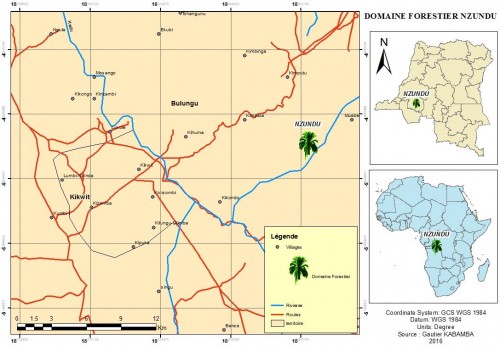Tropical Plant Research
An International Journal by Society for Tropical Plant Research
2017, VOLUME 4 ISSUE 3Pages: 363-375
Phytoecological study of Nzundu massif forest of Imbongo city, Kwilu Province, Democratic Republic of the Congo
Y. B. da-Musa Masens*, Koto-te-Nyiwa Ngbolua, Mandung Masens, Tembeni M. Tambu and Ngiala Bongo Gédéon
*Faculty of Science, University of Kinshasa, Kinshasa XI, Kinshasa, Democratic Republic of the Congo
Abstract:
Formerly, the Nzundu forest massif covered almost the two third of Kwenge and Imbongo, and a part of Kipuka districts. Nowadays, it is represented by a reduced forest fragment with a surface of about 50 to 70 hectares. The flora inventory was performed on the forest trees at dbh ≥ 10 cm, measured at 1.30 m of high at the breast height trunk, allowed to identify 134 different kinds of plants divided into 109 genera and 31 families. Fabaceae, Malvaceae, Rubiaceae, Euphorbiaceae, Moraceae, Meliaceae and Sapotaceae are the most represented families. The value of the basal area got in this forest massif is high or 49.89 m2.ha-1. As to the ecological spectra and phytogeographical distribution, mesophanerophytes, sarcochores, mesophyles and the Congolian-Guinea element are the most numerous. The density of the forest trees listed in this forest massif is of 422 trunks.ha-1. Brachystegia laurentii is the species having the highest number of feet or 11.8%. The values of Shannon and of Equitability indices calculated are of 4.7 and 0.9 respectively.
Formerly, the Nzundu forest massif covered almost the two third of Kwenge and Imbongo, and a part of Kipuka districts. Nowadays, it is represented by a reduced forest fragment with a surface of about 50 to 70 hectares. The flora inventory was performed on the forest trees at dbh ≥ 10 cm, measured at 1.30 m of high at the breast height trunk, allowed to identify 134 different kinds of plants divided into 109 genera and 31 families. Fabaceae, Malvaceae, Rubiaceae, Euphorbiaceae, Moraceae, Meliaceae and Sapotaceae are the most represented families. The value of the basal area got in this forest massif is high or 49.89 m2.ha-1. As to the ecological spectra and phytogeographical distribution, mesophanerophytes, sarcochores, mesophyles and the Congolian-Guinea element are the most numerous. The density of the forest trees listed in this forest massif is of 422 trunks.ha-1. Brachystegia laurentii is the species having the highest number of feet or 11.8%. The values of Shannon and of Equitability indices calculated are of 4.7 and 0.9 respectively.

Fig.: Map showing the location of study area.
| 0 | 1 | 2 | 5 | 5 | 0 | 3 | 1 |


